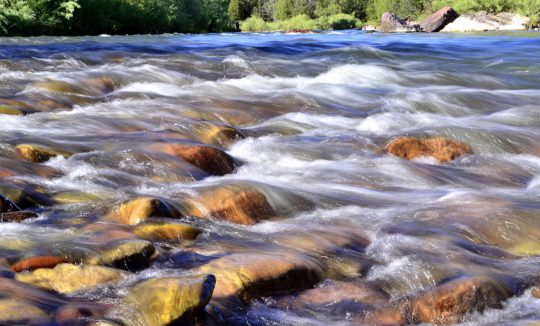
Drought Resilience
Drought Resilience in the Blackfoot Watershed
Drought cycles have always recurred in most climate zones, although in recent decades the American West has seen increasing impacts of drought on seasonal water supply. We cannot control the timing or severity of drought, but we can take steps to nurture ecosystem-wide drought resilience. The Blackfoot Drought Committee was formed in 2000 to coordinate and implement a voluntary drought response effort in the Blackfoot watershed. The Blackfoot Drought Response Plan is based on the premise of “shared giving” with the goal of involving all water users in a cooperative effort to minimize the adverse impacts of drought on fisheries and to aid in the equitable distribution of water during low flow periods.
Blackfoot Drought Response Plan
To meet the requirements of the in-stream flow water right for the Blackfoot River shared by the State of Montana and the Confederated Salish and Kootenai Tribes, the Blackfoot Drought Response Plan provides a framework for the shared sacrifice approach to drought management. It details activities of the Blackfoot Drought Committee as well as actions taken by water users at biologically based stream flow and temperature triggers. Although the plan is always evolving based on knowledge and experience, its foundation lies in the following:
- Drought is a watershed-wide issue that requires action by all water users.
- The Blackfoot Drought Committee monitors snow pack, precipitation, weather, stream flows, soil moisture, and water temperatures throughout the year and provides water users with information to help prepare for drought.
- When flows in the Blackfoot River fall below 700 cubic feet per second (cfs), consumptive water users, primarily irrigators, are asked to implement individual water conservation plans. Irrigators who meaningfully participate in drought response may avoid a call for water from the State and Tribes.
- To help sustain healthy fisheries, anglers are asked to observe voluntary fishing technique restrictions and fishing hours may be restricted if river flows and temperatures hit designated triggers.
Individual Drought Planning
The Blackfoot Drought Response Plan is based on meaningful participation from water users junior and senior to the in-stream flow water right who voluntarily reduce their collective water use during drought in order to maintain critical in‐stream flows. As a matter of equity, the plan aims to include junior users, senior users, small users, and large users throughout the entire watershed. Water users participate by following individual water conservation plans, tailored to their water rights, uses and conservation strategies.
Under the Blackfoot Drought Response Plan, water right holders junior and senior to the in-stream flow water right are asked to voluntarily reduce water consumption when flows reach predetermined thresholds. Prior to development of the Blackfoot Drought Response Plan, junior water users were required to stop water withdrawals if Montana Fish, Wildlife and Parks made a “call for water” in enforcing their water right. The Blackfoot Drought Response Plan offers an alternative to traditional enforcement by allowing junior water users who voluntarily conserve water or take other beneficial conservation action to potentially continue using their water. Through the basin‐wide pooling of water resources, the end goal of maintaining critical in‐stream flows during drought periods can be achieved.
The Milltown Water Right
In 2008, the State of Montana acquired an instream hydropower water right and converted it to a fisheries habitat right, managed by Montana Fish, Wildlife & Parks (FWP). This is known as the Milltown water right. With the State’s passage of the Confederated Salish and Kootenai Tribes (CSKT) Water Compact in 2015, the State agreed to split the Milltown water right into two separate and enforceable water rights: one for the Clark Fork River and one for the Blackfoot River, which will be jointly managed by the CSKT and FWP. The priority date for both of these rights is December 10, 1904. The enforcement of the Milltown water right began on April 24, 2025. For the Blackfoot River, the base flow requirement remains at 700 cfs.
For Blackfoot residents, any surface water rights junior to 1904 could be called in a drought year when the flow of the Blackfoot River at Bonner drops below 700 cfs. However, because of the long history of voluntary, collaborative drought management in the Blackfoot watershed, FWP and the CSKT have agreed to continue and expand the Blackfoot Drought Response Plan as the primary response to the Milltown water right.
If you have water rights that are affected by this change in priority date, Blackfoot Challenge staff can help you develop a water conservation plan for your property. Please contact Clancy Jandreau, Blackfoot Water Steward, at clancy@blackfootchallenge.org.
To learn more about the Milltown water right:
Milltown Fact Sheet
Milltown Community Listening Sessions Report